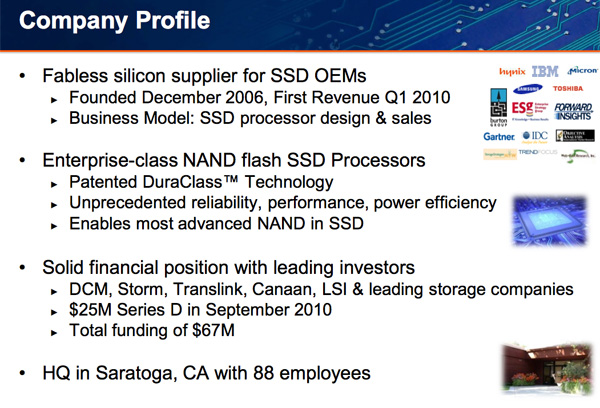SandForce Announces Next-Gen SSDs, SF-2000 Capable of 500MB/s and 60K IOPS
by Anand Lal Shimpi on October 7, 2010 9:30 AM ESTFinal Words
SandForce conveyed to me that although we may see hardware this year, production firmware and silicon won’t be ready until early Q1. Anything that ships before then is not what SandForce considers production worthy. This is an important distinction as SandForce’s partners often ship with pre-release hardware/firmware in order to gain traction and sales as quickly as possible. We’ll probably see less of this as SandForce matures as a company.
The specs behind the SF-2000 are downright amazing. If SandForce can deliver this sort of performance within two quarters I will be floored. If we’re talking about 500MB/s for a single drive next year, the sort of performance you’ll be able to get through a multi-drive array will be staggering. We’re easily heading towards gigabytes per second of affordable I/O bandwidth, not to mention that SandForce will have nearly maxed out 6Gbps SATA on its first attempt.
We will of course see drives from the usual suspects. OCZ, Corsair and even Seagate is now officially listed as a SandForce customer. Looks like those Pulsar rumors were true.
There’s still a long way to go before we’re at the point where we have a shipping SF-2xxx based drive with these specs however. If you remember the growing pains that Intel, Indilinx, Micron and SandForce all experienced with this current generation of controllers, I don’t expect the next round to be any easier.

SandForce is serious however. The company only has 88 employees but it just closed another round of funding ($25M Series D), bringing the total funding to $67M. The company is headed for an IPO. And if it can pull off the SF-2000 we saw on paper today, SandForce may have the sales to support it.










84 Comments
View All Comments
tipoo - Thursday, October 7, 2010 - link
...Isn't going to stay relevant long, is it? Already up to 500MB/s SSD's, and SATA 3 isn't even mainstream yet. Its going to become a bottleneck soon, just like SATA II is for current SSD's.rundll - Thursday, October 7, 2010 - link
Well, OCZ introduced few days back a new data link interface HSDL to handle Sata bottlenecks. Let's see what this means in real life.aguilpa1 - Thursday, October 7, 2010 - link
Break out your piggy banks if this is the wavejonup - Thursday, October 7, 2010 - link
They are a private company. As Anand said, a success of the new controller might force them in an IPOiwodo - Thursday, October 7, 2010 - link
Can we plug 2 SATA 6Gbps into a Single 2.5" SSD? We manage to max out SATA 3.0 in one go, and it is SATA 3.0 not even widely available yet.I hope the there would be at least some minor improvement in their DuraWrite and other part of the controller. Otherwise it looks like an overclocked Sandforce with better NAND interface to me.
Firmware should be less of an issues, since it is similar to older chips, the firmware should be stable enough.
Cant wait......
rundll - Thursday, October 7, 2010 - link
"...Otherwise it looks like an overclocked Sandforce with better NAND interface to me"Did we read the same article?
nexox - Thursday, October 7, 2010 - link
Ehh, you know 12Gbit SATA/SAS is due out in 2012, right? That's about in time for Sandforce's 3rd gen controller.And just because they've managed to double their bandwidth with this generation doesn't mean they've still got another trick up their sleeves to double their bandwidth again for the rev after this one.
Iketh - Thursday, October 7, 2010 - link
we're not talking physical limitations of a head moving back and forth on a spinning disk.... doubling performance at the least is much more the norm in the realm of silicon, nothing remotely close to a "trick" about itsoftdrinkviking - Friday, October 8, 2010 - link
I hope we get light peak before that; I just like the idea of my data flashing around through my pc in bursts of light. It's all so very "future is now."iwodo - Saturday, October 9, 2010 - link
No Trick, DDR NAND @ 133Mbps x 8 Channel already gives you just over 1Gbps SSD.And that is with CURRENT tech, the best thing about SSD is that it is easily scalable. You could do 10 Channel like Intel, ( Expensive ), or 16 Channel for total bandwidth since you get 16 Chips on a SSD.
You could also speed up NAND with DDR tech or small node but higher clockspeed.
The only limitation is how fast the controller could work. Which we still have much headroom.